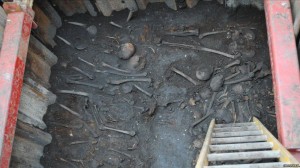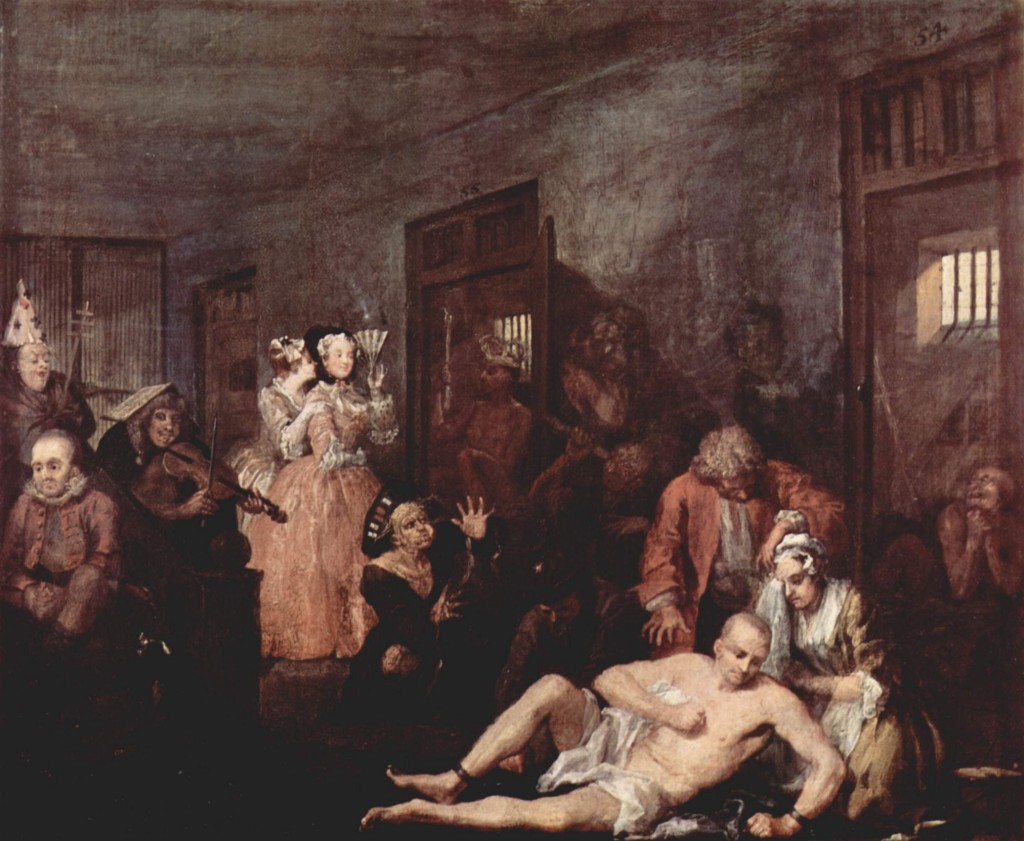 Archaeologists surveying a future site of the massive Crossrail project next to the Liverpool Street railway station have uncovered over a hundred skeletons in a burial ground that was used to inter patients from the infamous St. Bethlehem Hospital, aka Bedlam, starting in 1569.
Archaeologists surveying a future site of the massive Crossrail project next to the Liverpool Street railway station have uncovered over a hundred skeletons in a burial ground that was used to inter patients from the infamous St. Bethlehem Hospital, aka Bedlam, starting in 1569.
So far they’ve only dug a trial pit and found over a hundred skeletons starting just five feet below street level. Since the site is far larger than the small exploratory trench, lead archaeologist Jay Carver calculates that they will find hundreds more once the entire site is excavated, maybe even thousands.
This isn’t the first time the area has burst forth a glorious danse macabre courtesy of Bedlam’s hundreds of years of continuous use, first as a priory for the religious of the Order of the Star of Bethlehem in the 13th century, until the insane asylum that would become synonymous with a maddening racket moved to that location in the late 17th century. Four hundred skeletons were found next door when the office pedestrian complex Broadgate Centre was built during the 1980s.
The burial ground continued to be used until the 19th century for local residents when other intown cemeteries ran out of space, so not all of these skeletons are mental patients who died in the famously deplorable conditions of Bedlam; however, the huge numbers involved means there will be a high concentration of 16th century remains, both of the hospitalized and of the city poor.
‘It’s interesting on the archaeological side because the 16th century is a time of immense poverty really in the outer areas of the city of London. Sites of this type haven’t always been fully investigated,’ Carver said.
The team also uncovered pottery fragments, clay pipes, animal bone artefacts, including knife handles, and, as yet, unidentified implements in association with the burials.
The bodies will be studied at the Museum of London prior to reburial. Researchers will examine the gender distribution, their ages, and signs of chronic and terminal illness. The remains will then be re-interred locally, as per government regulations, but where exactly hasn’t been determined yet. Most of the bodies found in the ’80s were reburied under Broadgate Centre itself. East London Cemetery has accommodated past archaeological remains, but even they may not have the space for the numbers of skeletons expected to be found over the next two years of excavation.
St. Bethlehem Hospital was the world’s first hospital dedicated to the treatment of mental illness. I use the word “treatment” loosely, however, since mainly patients were kept in a chaotic, filthy, prison-like environment. They weren’t even called patients until 1700. Before that they were all “inmates” and there was no distinction made between curable and incurable cases.
In the 18th century, rich people would pay to visit the crazies and hoot at the spectacle behind their fans. Satirist William Hogarth depicted just such a scene in the last painting from his A Rake’s Progress series, where the titular rake’s moral degradation leads him from foppery to gambling to whoremongering to debtor’s prison to an ignominious naked finale as a shackled madman among the madmen of Bedlam, their wretchedness providing entertainment for his one-time society equals.

I suppose if Bedlam’s hundreds of years of continuous use started as a priory for medieval brothers of the Order of the Star of Bethlehem, you would still expect plenty of burials. But the brothers would have been buried with dignity, each in his own grave. Not thrown in some sort of unmarked pit.
They know the ages of these burials. They start in the 16th century, so a good 200+ years after the asylum was established.
No room for the dead! That Necropolis book, which you may remember, expressed the idea that much of London is built over old cemeteries. Both London and Paris eventually disallowed burials in the city, but Paris relocated its existing cemeteries to the Catacombs. London IIRC just built over a lot of them.
I do indeed remember. Still, individual burial grounds run out of space. Hence the proliferation of them all over the city at various times.
Wouldn’t it be cool to be digging in one’s vegetable garden and find a plague pit? :boogie:
Yes. Yes it would.
Not necessarily. I remember when I was 8 or 9, plague pits were uncovered during building work in London, and there was a lot of speculation, even panic in some quarters, about the possibility of live plague bacilli escaping into the population.
Does anyone know if they mistreated or tortured the insane in Bedlam? (Bethlehem, the longer version) If so, please tell me. 😉 :yes: :thanks: 😀 🙂
Bethlem (not Bethlehem) Royal Hospital was its official name for most of its life. Inmates were known to have been restrained with manacles, flogged, kept in solitary confinement. Waste disposal was inadequate so cells, clothes and straw palettes were often imbued with feces and urine. Conditions were better or worse at different times, but I think you can safely say that on the whole, patients were treated in ways that today would be considered abuse or neglect.
If you Wang a decent look at how psychiatry began (I can’t at the moment recall if it specifically covers Bedlam, but would certainly pertain to it) have a look at the book “Mad in America: Bad Science Bad Medicine and the Enduring Mistreatment of the Mentally I’ll.” By Robert Whitaker. Talks about how psychiatry began and how far and really not so far we’ve come. Worth it if you want to know how patients in such a time and place were treated as well as the relevance of psychiatry’s past to its’ current present.
:skull: do people stay in Bedlam till they die